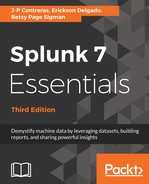Now, we will begin to make a Pivot; follow these directions:
- From the main data models list, click on Pivot in the main menu under Actions.
- This time, simply click on the WebLogs object. You will see a page shown in the following screenshot with a count of all WebLogs data for All Time:

We have highlighted different sections in this page. The navigation bar icons to the left of the screen represent the different visualization modes. The default and topmost visualization is the statistics table. Generally, you will first construct your statistics table and validate data before changing to other visualizations.
The time range filtering functions the same in Pivot as it does in the Search window. Consider changing it to something within the scope of your acceleration summary range (7 days in this case) to improve performance. Filters will allow you to narrow down your dataset based on the data model attributes we defined earlier in this chapter.
Split Rows and Split Columns will allow you to change the orientation of your data based on Time or Attribute. The following screenshot shows you what attributes will appear on the Split Columns drop-down menu:

Column Values on the other hand will allow you to select an Event or Attribute based on Time, as shown in the following screenshot:

In the upper-right corner of the page, you will see the scope of the Pivot. This is usually the object that you clicked when you first entered the Pivot editor. Through this dropdown, you can switch to other data models and other objects, as shown in the following screenshot. It is also a shortcut for checking the status of acceleration:

The Pivot editor will always default to the Count of the object that was selected in the data model. That is why, in the results section, you see Count of WebLogs:
